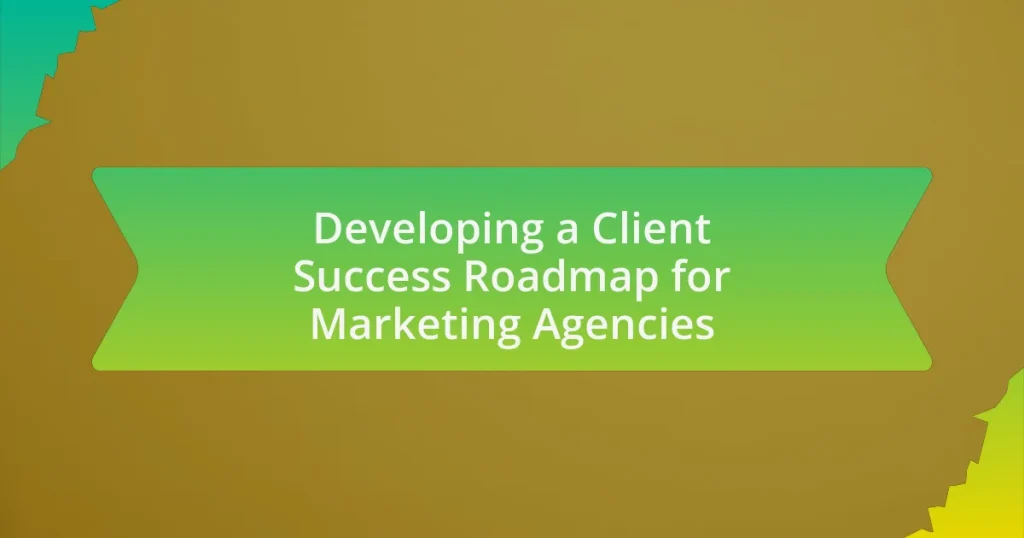A Client Success Roadmap for Marketing Agencies is a strategic framework designed to enhance client satisfaction and retention by outlining essential steps such as onboarding, goal setting, performance tracking, and communication. This roadmap not only aligns agency services with client objectives but also significantly improves client retention rates, with research indicating potential increases of up to 30%. Key elements include clear objectives, defined milestones, resource allocation, and performance metrics, all of which contribute to fostering long-term partnerships. The article further explores the benefits of a structured approach, common challenges faced without such a roadmap, and best practices for effective implementation, emphasizing the importance of client involvement and regular reviews to ensure ongoing success.

What is a Client Success Roadmap for Marketing Agencies?
A Client Success Roadmap for Marketing Agencies is a strategic plan that outlines the steps and processes necessary to ensure client satisfaction and success throughout the engagement. This roadmap typically includes stages such as onboarding, goal setting, performance tracking, and ongoing communication, which are essential for aligning agency services with client objectives. Research indicates that agencies with a structured client success approach can improve client retention rates by up to 30%, demonstrating the effectiveness of such roadmaps in fostering long-term partnerships.
How does a Client Success Roadmap benefit marketing agencies?
A Client Success Roadmap benefits marketing agencies by providing a structured approach to enhance client relationships and drive retention. This roadmap outlines clear objectives, milestones, and strategies tailored to client needs, ensuring that agencies can proactively address challenges and deliver value. Research indicates that companies with a defined client success strategy experience a 20% increase in client retention rates, which directly correlates to higher revenue growth. By implementing a Client Success Roadmap, marketing agencies can systematically track client progress, optimize service delivery, and foster long-term partnerships, ultimately leading to improved client satisfaction and loyalty.
What are the key elements of a Client Success Roadmap?
The key elements of a Client Success Roadmap include clear objectives, defined milestones, resource allocation, communication strategies, and performance metrics. Clear objectives outline the desired outcomes for client engagement, while defined milestones help track progress toward those outcomes. Resource allocation ensures that the necessary tools and personnel are available to support client needs. Communication strategies facilitate ongoing dialogue between the agency and the client, fostering transparency and trust. Lastly, performance metrics provide measurable indicators of success, allowing for adjustments to be made as needed to enhance client satisfaction and retention.
How does a Client Success Roadmap enhance client relationships?
A Client Success Roadmap enhances client relationships by providing a structured approach to understanding and meeting client needs. This roadmap outlines specific goals, milestones, and strategies tailored to each client’s objectives, ensuring that both the agency and the client are aligned in their expectations. By regularly reviewing progress against the roadmap, agencies can proactively address issues, celebrate successes, and adapt strategies as necessary, fostering trust and open communication. Research indicates that organizations with a clear client success strategy experience a 20% increase in client retention rates, demonstrating the effectiveness of such roadmaps in strengthening relationships.
Why is developing a Client Success Roadmap essential for marketing agencies?
Developing a Client Success Roadmap is essential for marketing agencies because it provides a structured approach to ensuring client satisfaction and retention. This roadmap outlines clear objectives, strategies, and metrics for success, enabling agencies to align their services with client expectations. Research indicates that companies with a defined customer success strategy can achieve up to 30% higher customer retention rates, demonstrating the effectiveness of such roadmaps in fostering long-term client relationships.
What challenges do marketing agencies face without a Client Success Roadmap?
Marketing agencies face significant challenges without a Client Success Roadmap, including misalignment of client expectations and ineffective communication. Without a structured approach, agencies struggle to define clear objectives, leading to confusion about deliverables and timelines. This lack of clarity can result in decreased client satisfaction, as clients may feel their needs are not being met. Additionally, agencies may experience inefficiencies in resource allocation and project management, as they lack a strategic framework to guide their efforts. Research indicates that organizations with defined client success strategies see a 20% increase in client retention rates, highlighting the importance of a roadmap in fostering long-term relationships and ensuring mutual success.
How can a Client Success Roadmap improve client retention rates?
A Client Success Roadmap can significantly improve client retention rates by providing a structured approach to managing client relationships and expectations. This roadmap outlines clear goals, milestones, and strategies for engagement, ensuring that clients receive consistent value and support throughout their journey. Research indicates that companies with a defined customer success strategy experience a 20% increase in retention rates, as they are better equipped to proactively address client needs and concerns. By fostering open communication and aligning services with client objectives, a Client Success Roadmap enhances satisfaction and loyalty, ultimately leading to higher retention rates.

What steps are involved in creating a Client Success Roadmap?
Creating a Client Success Roadmap involves several key steps: defining client goals, mapping the customer journey, identifying success metrics, developing a communication plan, and implementing feedback loops.
Firstly, defining client goals ensures alignment between the agency and the client’s expectations, which is crucial for success. Secondly, mapping the customer journey allows the agency to understand the various touchpoints and experiences clients have with the service. Identifying success metrics provides measurable indicators of progress and outcomes, enabling the agency to track effectiveness. Developing a communication plan establishes how and when updates will be shared with clients, fostering transparency and trust. Lastly, implementing feedback loops allows for continuous improvement based on client input, ensuring the roadmap remains relevant and effective.
These steps collectively create a structured approach that enhances client satisfaction and retention, which is essential for marketing agencies aiming to deliver value and achieve long-term success.
How do you define client success for your agency?
Client success for our agency is defined by the achievement of measurable goals that align with the client’s business objectives. This includes metrics such as increased revenue, improved brand awareness, and enhanced customer engagement. For instance, a case study from a recent campaign demonstrated a 30% increase in client sales within six months, validating our approach to setting and meeting specific performance indicators.
What metrics should be used to measure client success?
Client success can be measured using metrics such as Net Promoter Score (NPS), Customer Satisfaction Score (CSAT), Customer Lifetime Value (CLV), and churn rate. NPS gauges client loyalty and likelihood to recommend services, while CSAT assesses immediate satisfaction with specific interactions. CLV quantifies the total revenue expected from a client over their relationship with the agency, and churn rate indicates the percentage of clients who discontinue services over a given period. These metrics provide a comprehensive view of client engagement and satisfaction, essential for marketing agencies to refine their strategies and improve client relationships.
How can client feedback be incorporated into the roadmap?
Client feedback can be incorporated into the roadmap by systematically collecting, analyzing, and prioritizing client insights to inform strategic decisions. Marketing agencies can implement regular feedback mechanisms, such as surveys and interviews, to gather client opinions on services and expectations. This data can then be categorized and assessed to identify trends and areas for improvement, ensuring that the roadmap aligns with client needs. For instance, a study by Bain & Company found that companies that actively seek and act on customer feedback can increase customer retention by 10-15%. By integrating this feedback into the roadmap, agencies can enhance client satisfaction and drive better outcomes.
What strategies can be employed to implement the roadmap effectively?
To implement the roadmap effectively, marketing agencies should adopt a structured approach that includes clear communication, stakeholder engagement, and performance metrics. Clear communication ensures that all team members understand their roles and responsibilities, which is essential for cohesive execution. Engaging stakeholders, including clients and team members, fosters collaboration and buy-in, increasing the likelihood of successful implementation. Additionally, establishing performance metrics allows agencies to track progress and make data-driven adjustments, ensuring alignment with the roadmap’s objectives. Research indicates that organizations with defined communication strategies and stakeholder involvement experience a 25% higher success rate in project implementation.
How can team training enhance the effectiveness of the roadmap?
Team training enhances the effectiveness of the roadmap by equipping team members with the necessary skills and knowledge to execute the strategy effectively. When team members are trained, they develop a deeper understanding of the roadmap’s objectives, which leads to improved collaboration and alignment on goals. Research indicates that organizations with well-trained teams experience a 20% increase in productivity, as employees are more confident in their roles and responsibilities. This increased productivity directly contributes to the successful implementation of the roadmap, ensuring that marketing agencies can meet client expectations and achieve desired outcomes.
What tools can assist in tracking client success progress?
Tools that can assist in tracking client success progress include customer relationship management (CRM) systems, project management software, and analytics platforms. CRM systems like Salesforce and HubSpot enable agencies to monitor client interactions and satisfaction levels, providing insights into client engagement. Project management tools such as Asana and Trello help track project milestones and deliverables, ensuring that client goals are met on time. Additionally, analytics platforms like Google Analytics and Tableau offer data-driven insights into client performance metrics, allowing agencies to assess the effectiveness of their strategies. These tools collectively enhance the ability to measure and improve client success outcomes.

What are the common pitfalls in developing a Client Success Roadmap?
Common pitfalls in developing a Client Success Roadmap include a lack of clear objectives, insufficient understanding of client needs, and inadequate resource allocation. Without clear objectives, teams may struggle to align their efforts, leading to inconsistent client experiences. Insufficient understanding of client needs can result in strategies that do not resonate with clients, ultimately hindering success. Additionally, inadequate resource allocation can prevent the implementation of effective strategies, as teams may lack the necessary tools or personnel to support client success initiatives. These pitfalls can significantly undermine the effectiveness of a Client Success Roadmap, making it crucial for marketing agencies to address them proactively.
What mistakes should marketing agencies avoid when creating their roadmap?
Marketing agencies should avoid vague objectives when creating their roadmap. Clear, measurable goals are essential for tracking progress and ensuring alignment with client expectations. For instance, a study by the Content Marketing Institute found that 70% of successful marketing campaigns have well-defined goals, which directly correlate with higher client satisfaction and retention rates. Additionally, agencies must not overlook the importance of client input; failing to incorporate client feedback can lead to misaligned strategies and wasted resources. According to a report by HubSpot, 61% of marketers say that understanding customer needs is crucial for effective marketing, emphasizing the need for collaboration in the roadmap development process. Lastly, neglecting to regularly review and adjust the roadmap can result in outdated strategies that do not respond to market changes, as highlighted by research from McKinsey, which states that agile companies that adapt their plans frequently outperform their competitors.
How can lack of communication hinder the success of the roadmap?
Lack of communication can significantly hinder the success of the roadmap by creating misunderstandings and misalignments among team members and stakeholders. When communication is insufficient, critical information regarding goals, timelines, and responsibilities may not be effectively shared, leading to confusion and delays in project execution. For instance, a study by the Project Management Institute found that poor communication is a primary contributor to project failure, with 57% of project failures attributed to ineffective communication. This statistic underscores the importance of clear and consistent communication in ensuring that all parties are aligned and informed, ultimately impacting the successful implementation of the client success roadmap in marketing agencies.
What role does client involvement play in the roadmap’s effectiveness?
Client involvement is crucial for the effectiveness of a roadmap, as it ensures alignment between the agency’s objectives and the client’s needs. When clients actively participate in the roadmap development process, they provide valuable insights that help tailor strategies to their specific goals, leading to more relevant and actionable plans. Research indicates that projects with high client engagement have a 30% higher success rate, demonstrating that collaboration fosters better outcomes and satisfaction. This involvement not only enhances communication but also builds trust, which is essential for long-term partnerships and successful project execution.
What best practices can ensure the success of a Client Success Roadmap?
To ensure the success of a Client Success Roadmap, marketing agencies should prioritize clear communication, measurable goals, and proactive engagement. Clear communication fosters transparency and builds trust between the agency and clients, which is essential for long-term relationships. Measurable goals allow agencies to track progress and adjust strategies based on performance metrics, ensuring alignment with client expectations. Proactive engagement involves regular check-ins and feedback loops, enabling agencies to address client needs promptly and adapt to any changes in their objectives. These practices are supported by research indicating that effective communication and goal-setting significantly enhance client satisfaction and retention rates in service-oriented industries.
How often should the roadmap be reviewed and updated?
The roadmap should be reviewed and updated at least quarterly. Regular reviews ensure that the roadmap remains aligned with changing client needs, market conditions, and business objectives. According to industry best practices, quarterly assessments allow for timely adjustments based on performance metrics and feedback, which enhances the effectiveness of the client success strategy.
What are the key indicators of a successful Client Success Roadmap?
Key indicators of a successful Client Success Roadmap include client satisfaction, retention rates, and measurable outcomes. Client satisfaction can be assessed through regular feedback surveys, which provide insights into the client’s experience and areas for improvement. Retention rates indicate the effectiveness of the roadmap in maintaining long-term relationships, with higher rates reflecting successful engagement strategies. Measurable outcomes, such as achievement of client goals and ROI, demonstrate the tangible benefits of the roadmap, validating its effectiveness in driving client success.
What practical tips can marketing agencies follow to enhance their Client Success Roadmap?
Marketing agencies can enhance their Client Success Roadmap by implementing regular communication, setting clear expectations, and utilizing data analytics. Regular communication fosters transparency and builds trust, allowing agencies to address client concerns promptly. Setting clear expectations ensures that both the agency and the client understand the goals and deliverables, which can lead to improved satisfaction and alignment. Utilizing data analytics enables agencies to track performance metrics, providing insights that can inform strategy adjustments and demonstrate value to clients. These practices are supported by research indicating that effective communication and data-driven decision-making significantly improve client retention and satisfaction rates in service industries.


